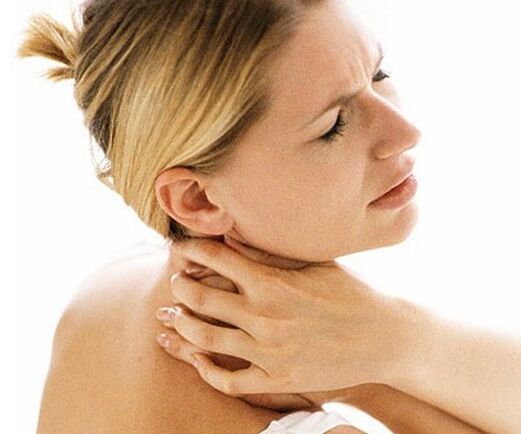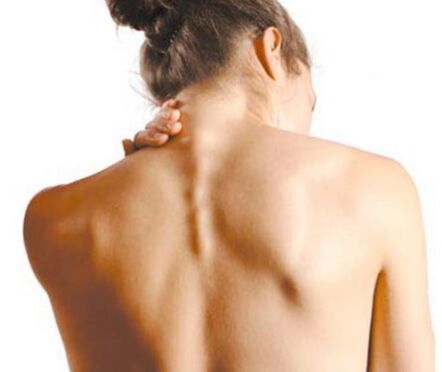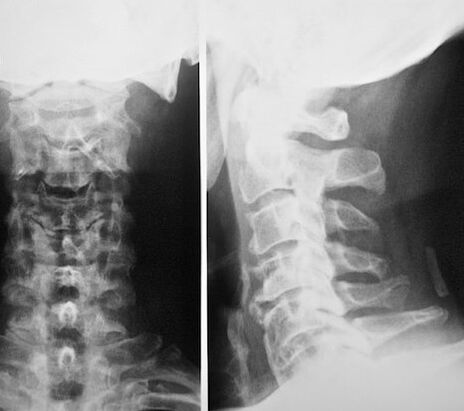Among all the diseases known by humanity, perhaps the most common are the diseases of the motor support system. It is unlikely that there is a person over the age of 40 who would have no problems with the spine, they do not complain about joint pain or muscles. The cause of this phenomenon often becomes a sedentary lifestyle, when, with age, with a decrease in motor activity, salts and other harmful substances are deposited in the joints that interrupt the functionality of the bone system. It is generally accepted that the diseases of support and motor sea openships appear only in people of mature age, but, however, in recent years, young people are often diagnosed with this type of illness. It is quite difficult to treat these diseases, especially when degeneratively - dystrophic changes that affect the cartilage, bones and closing nerve tissues. Among a series of diseases that violate the structure of the bone system, a special place is administered to a disease such as cervical osteochondosis, which is considered the most common disease of our time and is found not only in people of mature age, but also to young people under the age of 35.

Osteochondrosis of the cervical region is a progressive disease, such a premature treatment and following the search for a doctor: the plug can lead to human disability. What are these insidious diseases? What are the symptoms of cervical osteocondrosis and how to manage this disorder?
How does cervical osteochondosis develop?
Cervical osteochondrosis is a progressive disease characterized by degenerative changes - dystrophic in the intervertebral discs to which deformations are served, they change their structure, which cause a series of pronounced symptoms. At risk for the development of osteochondosis of the cervical region are people who guide a sedentary lifestyle or whose professional activity is associated with the body in a position for a long time. In terms of the incidence of osteochondrosis, the damage to the cervical column ranks second after the lumbosacral osteochondosis. The peculiarity and complexity of the disease is that the lesion of the cervical region almost always affects the nerve roots of the spinal nerves and intervertebral discs, due to which large and small vessels are defeated by the flow of blood to the brain.
The cervical compartment has a complex structure and consists of 7 vertebrae, each of which performs a series of functions: it supports the head, curves, folds the neck and other important functions. There are intervertebral discs between the vertebrae, which make the spine flexible and durable, and the intervertebral discs themselves are made up of fibrous rings, within which there are pulper cores. The cervical vertebrae adapt to each other, which is why even less physical activity can cause their movement, which in turn causes the blood vessels and nerves they hold. In the cervical column there are the vertebral arteries that are responsible for the flow of blood to the brain. When it compresses them, the flow of blood is disturbed, the brain does not receive a sufficient amount of vital substances, which undoubtedly leads to its defeat and the development of a series of complications, which can lead to the patient's disability or even death.

The main causes of cervical osteochondosis
Despite the prevalence of this disease and the result in modern medicine, the pathogenesis of the osteochondrosis of the cervical column has not been completely studied. It is known that the disease can develop against the background of metabolic altered processes in the cervical column, which over time leads to a change in the structure of the intervertebral discs and vertebral bodies. Among other types of osteochondrosis, the cervical is the most dangerous, since during its development there is a compression of the nerve roots of the spinal cord and blood vessels, which undoubtedly lead to a violation of the flow of blood to the brain cells. In the pathogenesis of the disease, doctors distinguish several provocative factors that can lead to the development of the disease.
- A sedentary lifestyle.
- Violation of metabolic processes in the body.
- Deposition of salt in the cervical region.
- Improper or unbalanced diet;
- Long -term interruption of the body in one location: work on the computer, drive a car.
In addition to the factors that can lead to the development of cervical osteocondrosis, experts distinguish people who are at risk for the development of this disease.
- Genetic predisposition.
- Lesions of the cervical column.
- Long -term or periodic hypothermia of the body.
- Hormonal imbalance.
- Chronic diseases of the support and motor system: rheumatism, scoliosis, systemic lupus erythematosus.
- Overweight.
The reason for the development of cervical osteochondosis can be other causes, but in any case the disease should be treated in its first signs.
How to recognize osteochondosis of the cervical region and what are your signs?
The clinical signs of cervical osteochondrosis The osteochondosis of the cervical column develops slowly. The symptoms of the disease depend on the degree and the number of damaged vertebrae and the pinching of nerve endings. The main symptom of the disease is the pain of different intensity in the spine, in the neck, in the lower back of the back, which are administered to other organs. Only a doctor can diagnose "cervical osteochondrosis" after the results of the exam, since the diversity of the clinic of the disease often resembles other pathologies, but everyone can suspect this disorder.
- The pain in the neck, which gives the back of the head, ears, front part, forearm, chest, shoulder. Painful sensations of different intensity have improved by minimal loads or turns to the head.
- Numbness of the upper and lower limbs, burning, tingling.
- Headache, dizziness.
- A rupture.
- Darking in the eyes, "flies" in front of the eyes.
- Fainting with a sharp round of the head.
- Noise in the ears.
- Numbness of the language.
- Violation of coordination.
- Reduce hearing, visual acuity.
- Pain in the heart.

The clinical signs of osteochondous of the cervical region, expressed and appear while the disease develops and progress. The doctors engaged in the treatment of this disease distinguish several cervical osteochondrosis syndromes, each of which has its own characteristics and manifest themselves according to the damaged nervous column.
- Rest syndrome - develops following the pinching of the first couples of nerve endings in the cervical column. The patient feels severe pain in the neck, which is administered in the scapula, in the lower back, in the shoulder and in the forearm.
- The spinal artery syndrome is characterized by a pulsating headache in the back of the head or temporal region. Making the pain that burns the syndrome from syndrome in the neck and nape, which intensifies when turning the head, sleep or cough, gives the chest and shoulder.
- Cardial syndrome is an entire group of symptoms that they initially resemble the symptoms of the angina pectis. This syndrome develops in case of damage to the spine of the diaphragmatic nerve or the large thoracic muscle. The main signs are considered overwhelming in the heart that do not pass after taking nitroglycerin. These pains can last several hours, intensify while driving or deep breathing. In the patient, these symptoms cause panic, as they look like a heart attack.

Symptoms of cervical osteochondosis
Cervical osteochondrosis - Symptoms and treatment depend directly on the damaged nervous column. The number of cervical roots is 8 and the cervical vertebrae are 7. Each cervical nerve is above the vertebra and with the damage it has its symptoms.
If there has been a defeat of the first and second cervical vertebra (Ci-II), the sensitivity of the back of the head will be disturbed, which attracts pain in the parietal and occipital region.
The lesion of the nervous ending (C3) is extremely rare, but nevertheless, when it is damaged, the patient feels numb in the neck, in the area where the pinch occurred. Speed, the sensitivity of the language are also compromised.
The lesion of the C4 nervous column causes pain and numbness in the collar or shoulder. There are disorders in the respiratory system, pain in the heart.
If the vertebral segment of the 5th department is disturbed, the patient will also feel the pain that spreads on the shoulder, the external surface of the shoulder, the sensitivity of the upper and lower limbs is also disturbed.
Pinching the roots of C6 and C7 the most common phenomena among patients. Patients feel neck pain, blade, forearm, back, lower back, sensitivity of the hands, fingers.
When the nervous spine is affected, then the pain will spread throughout the neck, in the back, in the elbow and gives it to the lower limbs. You can see the numbness of the small fingers on the arms and legs, the sensitivity of the skin is practically absent. The legs and hands of the hands acquire a bluish tint, due to the compromise of blood circulation.
In addition to pain syndromes, a patient with cervical osteochondrosis also complains of other ailments described above in the signs of the disease: altered vision, dizziness, fainting, etc.
Physical education of media for cervical osteochondosis
It is necessary to perform and conduct physiotherapy exercises only after consulting a doctor. In addition, the movement should discuss each execution with a specialist, since the incorrect position of the neck or limbs can still damage health and aggravate the treatment. Consider some sure exercises that they can and should be performed for patients with cervical osteochondrosis.
- In a position lying on a flat surface, it spreads the arms on the sides. Raise your arms, turn the body with light movements a little left, right. The left palms of the hand touch the right palm and vice versa. Do these exercises 5 - 6 times.
- In a position lying on the stomach, it stretches your arms along the body. Try to relax the muscles and slowly turn your head to the left, then to the right. It is necessary to try to touch the edge of the ear. Such an exercise can be performed standing, as in the photo. Perform 8-10 times.

- Lie on the stomach, try to tilt your chin in the palm, the neck muscles must be relaxed. Make 5 times.
- Drink your head a little, then gradually lower it. The neck muscles will resist, therefore such an exercise must be performed with care. Repeat the exercise 5-6 times.
- You have to get up exactly, straightened your shoulders. So slowly turn your head to the right, then left. So 5 - 6 times.
- Speakes the fingers on the back of the head, put the elbows together, put the chin of the forearm. Try to increase the reduced forearm as high as possible. Repeat such an exercise 5 - 6 times.
- Take your knees. With slow movements, he raises his head and freezes the body, lengthening his arms forward. So 5 - 6 times.
Physical education is quite effective in the treatment of cervical osteocondrosis, but all exercises must be performed regularly and correctly. Of course, the condition does not improve from the first classes, so you have to be patient.
Treatment of the osteocondrosis of the cervical department with popular remedies
Traditional medicine has also demonstrated its effectiveness in the treatment of cervical osteocondrosis, which for decades hundreds of years has collected a large number of recipes in its arsenal which will help reduce the symptoms of the disease. The treatment of osteocondrosis with popular remedies is to use vegetable and animal products for external or internal use.
Recipe 1. Cervical osteochondosis honey. You will need 1 - 2 teaspoons of natural bees honey, 2 mummy tablets. The honey and mummy must be heated, wear a hot scarf and attach around the neck for the night. Honey has an anti -inflammatory and biostimulating property, therefore it can perfectly integrate the treatment of this disorder.
Recipe 24 - 5 grams of celery must be poured with 1 liter of boiling water, insist 2-4 hours, filter and take 1 large tablespoon 3 times a day.

Recipe 3. A decoction of chamomile and olive oil. You will need 30 grams of chamomile flowers, 0, 5 l of olive oil without pieces. Chamomile flowers must be poured into the oil, put a small fire, bring to a boil and leave to cool. It is necessary to insist on a decoction for 2 days, then filter the full and rub the sick areas with the resulting oil. Together with chamomile, other herbs can be used: curtains, calendula, St. John's Wort. If there is no olive oil at hand, you can take the sunflower.
There are other means of traditional medicine that help to relieve the symptoms of cervical osteochondosis. However, it is important to remember that this treatment is effective only at the beginning of the development of the disease and can only be used in a complex treatment with traditional methods.
Prevention
Prevention of osteochondrosis of the neck is an active lifestyle. In cases where there is a place for the development of this disease, it is necessary to periodically visit a doctor - orthopedic. An important place from food is no less important, which should be useful, rich in vitamins, minerals and other charitable substances. The prevention or correction of excess weight, as well as regular physical exercises, reduce the risk of developing cervical osteochondosis several times.

















































